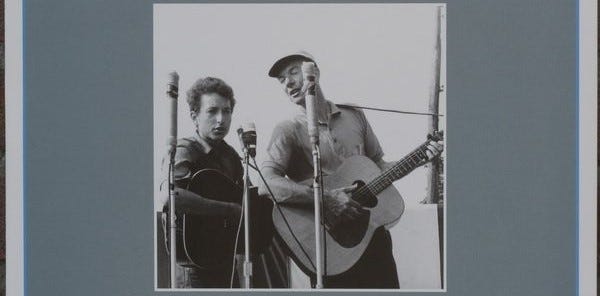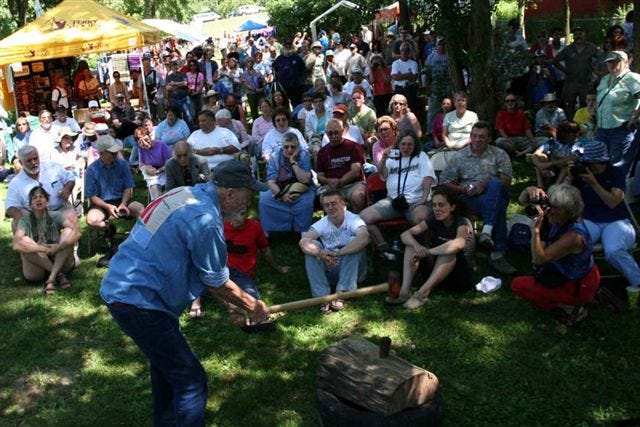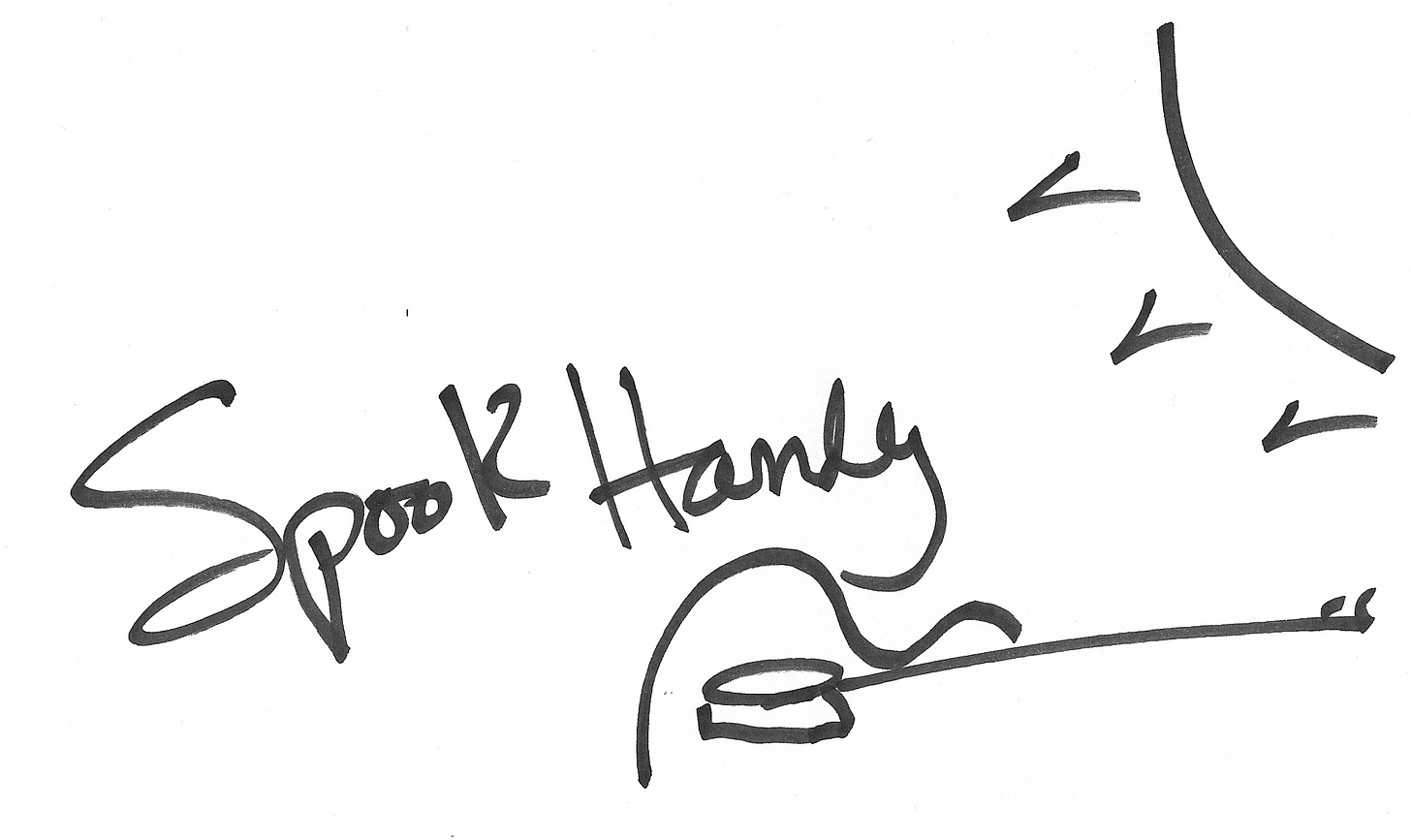Pete Seeger - What “A Complete Unknown” Missed
post 70
SPOILER ALERT
If you haven’t seen the movie yet, you probably don’t want to read this episode of “Looking for America.”
HIGHLY RECOMMENDED
Also, If you haven’t seen the movie yet, see it! This movie can be instructive to anybody who uses the word “folk music” to describe what they do – musicians, presenters, organizations, volunteers and more. Despite a healthy handful of anachronisms (- that’s a fancy word for stuff that’s not presented in the right time frame), the overall gist of the movie – with some minor and one major exception - fits what I have learned over the years.
EDWARD NORTON’S PORTRAYAL OF PETE SEEGER
Ed did a good job. He got many of the mannerisms right – the way Pete stood, the hands in his pockets, the cadence of his speech, and some of his stage gestures. But one major quality was missing.
PETE WAS A FIERCE ANCHOR
Pete was correctly portrayed as an accommodating, generous, flexible, peace-seeking, idealist. But the way it came off can be summed up by a question asked by an older couple. “Why did they portray Pete (and Toshi – Pete’s wife) as weak?” I was not surprised by the question.
One of my twenty-something guitar students asked, “Was Pete really a musical Mr. Rogers?” The answer is No.
Pete was aware of his fallibility and that his beliefs could be wrong. He told me several times in the last two years of his life, “I’ve made a lot of mistakes.” In one of his songs, he sings, “I may be right, I may be wrong.” But his self-awareness came from his inner strength and wisdom.
Pete was accommodating and flexible, not out of weakness, but out of strength - not because he doubted himself, but because he understood that each person has their own journey and experiences, and these, in turn, shape their perceptions. Pete was firmly committed to a vision that included making room for others with different visions.
Portraying these qualities more explicitly would have helped the general public—especially young people coming of age after Pete left this world—understand who Pete was, why he was so vitally important, and why he represented the best we humans can be.
PETE’S GENEROSITY
Pete was also one of the most generous people I ever met. And I don’t mean materially. I’ve heard stories that he was that, too. But I’m talking about his sharing the stage and spotlight.
Pete was the vortex at the center of the universe of American folk music. Throughout his career, he invited hundreds of lesser-known musicians to stand ten feet away and sing with him. I was one of them, and I fell into the vortex.
The first time Pete invited me to play at a festival, he wrote, “We can’t pay you, but we can give you pumpkin pie.” I didn’t care about monetary compensation. The experience was priceless. And nobody got paid anyway.
At the festival, hundreds of people gathered around to see Pete’s midday set. Halfway through, with the crowd at its zenith, he invited me on stage, said wonderful things about me, and stayed to sing harmony on my song “Vote!” THAT’S the kind of generosity I wish were more emphasized in the movie.
WHAT TO DO WITH FAME AND POWER
In the movie, Pete introduced young “Bobby Dylan” in a similar fashion. It was not just a kind gesture. Pete was setting an example of reaching back to pull the next guy up and making room to include new younger people into the circle. He showed that THIS is what you do with fame and power. You use it to make the world a better place, including getting more people on board.
DYLAN GOES ELECTRIC
The movie’s portrayal of Dylan’s electric set at the 1965 Newport Folk Festival and Pete’s reaction to it, was closer to the story I heard from Pete himself than to what I’ve heard in the public square over the past forty years. I am happy the movie didn’t portray Pete as a villain. But according to my perspective, which comes two-thirds from personal interactions with Pete and one-third from what Pete told me, here’s what they missed.
A WAY-SHOWER
Pete was a way-shower, but he gave room – heck, he made way - for the individual to make his own decisions and walk his own path. Pete had no major objections to Dylan going electric. There were, after all, other groups at the festival that played electric instruments. But, Dylan did it in a manner that essentially flipped the bird at Pete and folk music.
Pete wanted Dylan to show the bridge between folk and electric music. Isn’t that what Johnny Cash did? But Dylan’s set was more of an in-your-face rejection of folk music – a public display that he was bigger than the “folk” label he felt was boxing him in. He needed to break out.
And break out, he did. It can be argued that Dylan invented “folk rock.” But he didn’t do so by pushing the envelope. He recklessly obliterated the boundaries. He used shock and awe, to explode his own musical roots. He showed as much contempt as possible by producing a horrible, screeching, distorted, way-too-loud sound.
It was the 1965 version of folks in cars today with tinted windows speeding 60 miles per hour in a 25 mph residential zone with amplifiers instead of mufflers on their exhaust systems. It was a way to flip the bird at society. (There’s that term again.) In that way, Dylan was also a progenitor of punk rock.
Pete objected more to Dylan’s attitude and the horrible sound than to Dylan’s playing an electric instrument. The “sound” I am referring to was not Dylan’s playing or style. It was the quality of what was coming through the speakers.
Pete’s version of what happened was similar to how it was portrayed in the movie. He ran to the sound crew to get them to do something about the horrible sound and the crew told him this was how Dylan wanted it. That’s possibly the most important thing about this incident - Dylan wanted it to sound horrible. He wanted to dys everybody he was dysing.
Pete was dismayed and said something like, “Somebody should take an axe to the (wires).” But the urban myth of Pete actually grabbing an ax and having to be restrained or else he would have chopped the wires is simply untrue.
My perspective could be wrong. But here’s the point. Pete was no pushover. He didn’t cave to Dylan or anybody else. He was not overridden. And he certainly wasn’t weak.
THE BEST PATH
Instead, Pete was a powerful wise man who let people make their own decisions. Not for his self-preservation or political expediency, but because it gave the other guy more room to grow. He opened doors and gave guidance, but he let people do what they were going to do. I wish THAT was made more clear in the movie.
A RELIC?
Another friend thought the movie portrayed Pete as a relic of the past. If there’s any truth to this, even today, I fear for the future. I will soon share ideas about how we can revive some of the public’s appreciation of the values Pete personified - how we can do one spoonful more to help…
Keep the Flame Alive!
If you find this series valuable, please consider upgrading to a supporting subscriber. This way I can keep “Looking for America” free for those who cannot afford it, and continue writing and giving concerts of hope and optimism, especially in these very challenging times when a clear path through the darkness is not always easy to see.





My recollections of Pete’s generosity and Toshi’s toughness echo yours. One Clearwater festival they invited me, a total stranger, to sleep on their bed while they patrolled the grounds! Heroes and models to be sure.
A bunch of Pete friends saw the film together: Sarah Underhill, Betty Boomer, Melissa Ortquist and several others. We all thought similarly to what our shared as insights. Excellent film even with quiches.
Love you, Spook. Parrots For Peace send love.